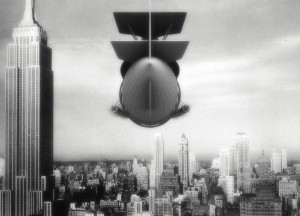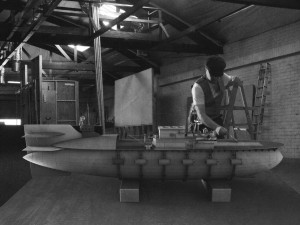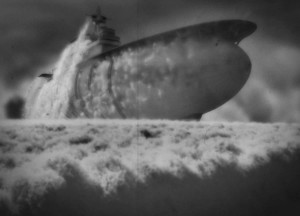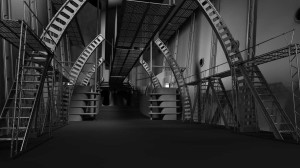
The film tells the story of Dr. Obsidian, a comic book hero that got its start in the late 1930s. Production of a Dr. Obsidian film was scuttled when war broke out. Afterward, financial issues prevented Brazen Pictures from re-establishing the character. With the introduction of television, Brazen planned to resurrect the property some years later, only to have the plans thwarted by scandal involving one of the actresses. A campy, psychedelic version almost made it to television during the 1960s. Then, during the comic-book craze in the 1990s, the property was optioned and now appears ready for a near-future return to the silver screen.
Shot in a variety of styles – from film noir to psychedelic sixties to high-def – the film includes numerous CG shots created with LightWave 3D software. “We had to crank out the effects at a high rate of speed and at minimum expense, and LightWave enabled us to do that,” said Kochinski. “So when it came time to create Dr. Obsidian’s backstory – and the premise of the film – there was no question that LightWave would play a major role in the production.”
 According to the filmmaker, it was crucial to have the film reflect the period it is supposed to have been shot in. Because a large part of Dr. Obsidian uses the 1930s back-and-white style, the film has to appear aged and broken down. This includes many greenscreen sequences in which the actors had to be inserted into CG sets built in LightWave or occasionally into photographs of old sets and locations.
According to the filmmaker, it was crucial to have the film reflect the period it is supposed to have been shot in. Because a large part of Dr. Obsidian uses the 1930s back-and-white style, the film has to appear aged and broken down. This includes many greenscreen sequences in which the actors had to be inserted into CG sets built in LightWave or occasionally into photographs of old sets and locations.
A large portion of the action was filmed against greenscreen, so virtual sets were important, many of which were created within LightWave. One of the first and the biggest CG backdrops is the interior of a zeppelin, which serves as the villain’s command center. In all, approximately 30 to 40 percent of the imagery is CG.
For constructing the buildings, sets and futuristic weapons and aircraft, Kochinski used the LightWave Modeler. “Modeling in LightWave has always been superb,” he said. “I have been building spaceships for Star Trek to Babylon 5, and now for Dr. Obsidian, in LightWave. The rendering out of the box is excellent, especially if you know how to use it properly. It is a very powerful tool. You can get really fantastic photoreal effects.”
 Kochinski likes LightWave’s intuitive interface and the fact that everything is logical and where it should be. “It’s a hard thing to explain when you have worked with the software for as long as I have, but it is organized in a way that makes sense.”
Kochinski likes LightWave’s intuitive interface and the fact that everything is logical and where it should be. “It’s a hard thing to explain when you have worked with the software for as long as I have, but it is organized in a way that makes sense.”
The filmmaker also likes that Modeling and Layout are separate sections, coinciding with his workflow. When starting a project, Kochinski skips the sketch-design process and dives straight into modeling in LightWave. “The pipeline supports this. I design in 3D to see what works and what doesn’t, so I design and build simultaneously,” he explained.
One of Kochinski’s favorite features within LightWave is the Edge Bevel tool. “Adding beveling properly adds a lot of realism to what you are doing,” he said, noting that the Cloning tool also works well for the art-deco look of the sequences in Dr. Obsidian. “I am doing a lot of beveling and cloning, and repeating of geometric shapes, adding hierarchies to get the effects I need.”
 Most of the digitally enhanced sequences are from the 1930s scenes, so Kochinski used bump maps for the textures. “They are almost all procedural textures at this point,” he said. “We are talking about flat, painted surfaces that are shades of gray. So when we do photorealistic renders [inside LightWave], they tend to look pretty good.”
Most of the digitally enhanced sequences are from the 1930s scenes, so Kochinski used bump maps for the textures. “They are almost all procedural textures at this point,” he said. “We are talking about flat, painted surfaces that are shades of gray. So when we do photorealistic renders [inside LightWave], they tend to look pretty good.”
Even though LightWave offers a virtual camera, Kochinski incorporated subtle camera moves into the production, mimicking those used in the 1930s. He is also mimicking the period’s classical stage lighting within LightWave by using three-point lighting, backfill and key lighting.
LightWave’s unique Viewport Preview Renderer (VPR) interactive renderer enables him to experiment with lighting, textures, volumetrics and shading right in the LightWave viewport and get immediate feedback. “The renderer is fantastic,” said Kochinski. “When set up properly, you get really wonderful, photorealistic effects.”





